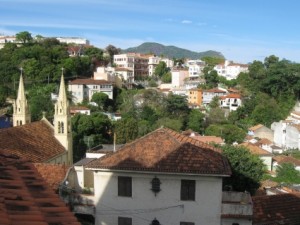
Photo © Michael Sommers.
I arrived in Rio de Janeiro last Saturday afternoon and, as usual, felt a sudden thrill as I stepped out of Tom Jobim International Airport and boarded a bus bound for the downtown district of Centro.I can always count on Rio to send my dopamine levels into overdrive. Unfortunately, my pleasure at being in the Cidade Maravilhosa took an unexpected hit soon after my arrival. In Centro, no sooner had I climbed into a taxi bound for my hotel, when I was unceremoniously ejected from the vehicle by the driver. Prior to my being kicked to the curb, the following exchange took place:
Me: “Can you take me to Santa Teresa please?”
Cabbie: “Where in Santa Teresa?”
Me: “Rua Almirante Alexandrino.”
Cabbie: “I don’t know that street.”
Me: “It’s one of the main streets in Santa Teresa.”
Cabbie: “I don’t know Santa Teresa. Do you know where the street is?”
Me: “I’ve been there before. But I can’t remember how to get there.”
Cabbie: “Well, then I can’t take you there. Get out.”
For those unfamiliar with Santa Teresa, it’s only one of Rio’s most centrally located, historically rich, downright charming, and hip and happening bohemian neighborhoods. As Montmartre is to Paris, Santa Teresa is to Rio (albeit with fewer tourists and much more tropical foliage). So unless the cabbie had just gotten off the boat (unlikely viewed his potent Carioca accent), he was me enrolando (i.e. “screwing me around”).
I found out the reason why soon after hailing my next cab. This time, already gun shy, I cautiously announced that I was Santa Teresa bound before going through the trouble of loading my luggage and myself into the taxi. The driver didn’t look happy at all. But he did agree to take me to Santa Teresa. On his way up the winding cobblestoned hills, I poured out to him my previous taxi driver woes, which resulted in the following exchange:
Me: “The other cabbie said he didn’t know Santa Teresa.”
Cabbie No. 2: “He was lying. He just didn’t want to take you there.”
Me: “Why not?”
Cabbie No. 2: “Taxistas don’t like taking people to Santa Teresa. They don’t make enough money on the fare and it can be hard to find passengers to bring back down. The hills are steep; in fact, when it rains they become rivers. Nobody will take you when it rains.”
Me: “So how does one get there?”
Cabbie No. 2: “Residents of Santa Teresa know that cabbies don’t want to take them. That’s why they ask very nicely; ‘Please, for the love of god and Our Lady, could you possibly do me the favor of taking me up to Santa Teresa?’”
Me: “Really? And that works?”
Cabbie No. 2: “It helps. For instance, when you opened the door and merely uttered ‘Santa Teresa’ to me – it almost made me not want to take you.”
Me: “Oh okay. Well, thanks for taking pity on me.”
The thing about taxis and Santa Teresa is that the former is essential to the latter. Walking up the steep switchbacks that lead to the neighborhood is a scorching experience on a sunny day, a diluvial one on a rainy day, and a dangerous one on a dark night (not to mention an exhausting one regardless of the time).
Last year, the iconic yellow bondes (trams) that had transported people to and from Centro and Santa Teresa, stopped running following a catastrophic accident in which 5 people were killed and 57 injured. Since then, the only remaining form of public transportation consists of small buses that only depart from Carioca Metrô station in Centro. Moreover, they only run until 10 at night. So taxis are a must. Especially if you are carrying any form of serious luggage.
Speaking of luggage, the following day, I had to lug mine to another hotel in Botafogo. As I wasn’t up to a 30-minute hike down the hill in noonday sun, the hotel called around to see if there were any taxis in the vicinity. Assuming it would take a while, the reception advised me to go chill out by the pool. Surprisingly, I didn’t have long to chill. With miraculous speed, a driver turned up in less than 10 minutes. His quickness, however, was off-set by crankiness.
As we hurtled down the hills, the driver complained to me that he had received a call from the dispatcher to pick up a passenger who wanted to go from Centro to Ilha de Governador (where the cabbie lives and usually works). However, once he picked up his fare, she confessed to him that she had no intention of going to Ilha de Governador. Her true destination was Santa Teresa.
Cabbie No. 3: “She lied to the dispatcher.”
Me: “How do you know?”
Cabbie No. 3: “It’s a common trick. Everybody knows nobody wants to go to Santa Teresa. These cobblestoned streets are terrible. They totally destroy a car’s suspension system. But after I had driven all the way to pick her up what was I going to do? Luckily, your hotel called so it’s not a total waste since I get to take you down.”
Me: “Glad I could be of service.”
Although it’s not a cinch to get down from Santa Teresa by taxi, it can be surprisingly difficult to get up. However, having surveyed close to a dozen Carioca cabbies over the past week, I’ve gathered a few tips of the trade on how to deal with reluctant drivers: